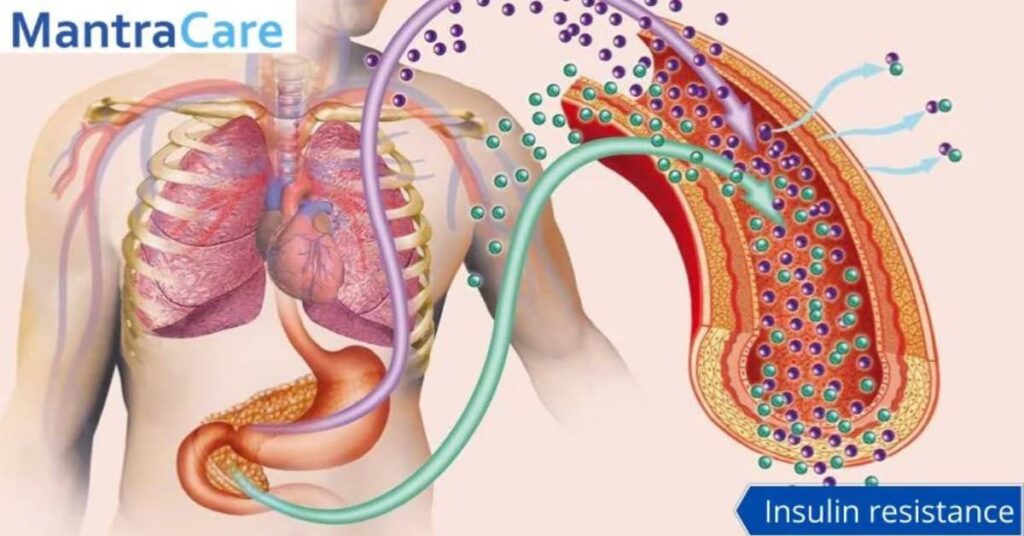Contents
What Is Insulin?
There are various hormones released by the digestive system to digest the food consumed by the person. Insulin is one such hormone that is released by the pancreas. Insulin when it gets released from the pancreas it has two major functions to perform. When you eat a carbohydrate-rich meal the carbohydrate is broken down into glucose molecules. The insulin is then released from the pancreas as the amount of blood glucose level rises.
The cells in the blood contain insulin receptors. The glucose molecules attach themselves to the insulin and are then sent inside the cell for proper utilization. Sometimes the cells do not need sugar to produce energy at that time. In such cases, the insulin sends the glucose molecules in the muscle cells, fat cells, and liver to store them for later use. The glucose when stored for later use becomes glycogen. The glycogen is released from the stored cells when a person starves or does fasting.
What Is Insulin Resistance?
In some cases, the insulin does not respond to glucose present in the blood and the blood sugar level rises. This causes more amount of insulin to be released from the pancreas to overcome the weak response of the cells to the insulin. This condition is known as insulin resistance. The insulin resistance does not respond to the glucose present in the stored form in the muscles, fats, and liver.
The cells present in the muscles, body fats and liver ignore the signal sent by the insulin and do not let the stored glucose be absorbed by the blood cells for production of the energy. The glucose present in the bloodstream may get accumulated in the blood and give a rise in the blood sugar level. This leads to diabetes if it continues for a longer period. It can lead to various complications in the body including obesity, hypertension, high cholesterol, and type 2 diabetes.
Effects of Insulin Resistance
When one develops insulin resistance the body tends to fight against the situation by producing more insulin. This causes excessive stress on the cells of the pancreas producing insulin and leads to their worn out. As years pass by the cells of the pancreas become worn out and produce either minimal insulin or no insulin at all which gives rise to prediabetes or type 2 diabetes. You also develop an increased chance of getting liver and heart disease. Insulin resistance in the body can also lead to non-alcoholic fatty liver disease.
Prediabetes is a condition in which the blood glucose levels in the body are higher than the normal value but are not high enough to be diagnosed as diabetes. Prediabetes occurs in people who are in the initial stage of insulin resistance or those people whose pancreatic cells are not making enough insulin to keep the blood sugar level under control. If prediabetes is not treated on time and it remains for a longer period then it might lead to type 2 diabetes as the blood glucose level in the body does not reach the normal value.
Causes of Insulin Resistance
Insulin resistance is generally caused due to excessive body weight and fats, a sedentary lifestyle, and genetics.
Obesity

Obesity or excessive body fat present in the abdomen region and around different organs is called visceral fat is a leading cause of insulin resistance. If you have a waist of 40 inches(men) and 35 inches (women) then you are prone to the disease. It doesn’t matter whether your body mass index is normal or not. The presence of fats in the body indicates the accumulation of glucose which needs to be utilized when the glucose level in the blood drops.
The glucose present in the body keeps getting accumulated when the insulin is not able to act upon it leading to an increase in the bodyweight of that person. This occurs due to insulin resistance developed in the body. The presence of body fat has also been linked to the long-lasting inflammation in the body which is responsible for insulin resistance and can also cause various cardiovascular diseases.
Inactive Lifestyle

An inactive or sedentary lifestyle is the cause of various diseases and ailments in the body. It is necessary to keep yourself involved in physical activity or any sort of exercise. When a body is involved in physical activity the absorption of the glucose present in the blood is high and the blood glucose level is maintained. But an inactive lifestyle causes changes in your body which may lead to insulin resistance in the body due to reduced need for energy causing lower absorption of glucose in the blood cells.
PCOS

PCOS or polycystic ovary syndrome is a condition in women in which there is an increased amount of production of insulin in the body. This increased amount of insulin can lead to insulin resistance over some time. Women with PCOS are at higher risk of getting insulin resistance.
Some people have certain medicines which have a high amount of steroids present or voluntarily take steroids to increase their body function. But intake of steroids for a longer duration of time can lead to continuous high blood sugar which can make your body insulin resistant. If further complications arise, you may suffer from type 2 diabetes.
Stress

Chronic stress and improper sleeping patterns are also known to cause insulin resistance in the body. The body which remains under stress for a long period produces the hormone cortisol which acts like steroids. An increase in the number of carbohydrates and sugar can also cause an increase in the blood sugar level and over time it may develop insulin resistance and lead to serious diseases like diabetes if left uncontrolled.
Other Causes
Other causes and risk factors associated with the disease are gestational diabetes, health conditions, family history of diabetes or genetic, smoking, ethnicity, above 45 years of age, hormonal disorders, sleep problems, and HIV medicines.
Signs And Symptoms Related To Insulin Resistance
Insulin resistance at the initial stage does not show any signs and symptoms of the disease. The insulin production in the body increases as there is an increase in the resistance of cells towards glucose and insulin.
On-set of Disease
The initial stage does not develop symptoms as the blood sugar level is maintained by the production of excess insulin. But as time passes the pancreas starts to wear out and is not capable of producing an excess amount of insulin which causes a rise in the blood sugar level. This spike in the blood sugar level may be your first symptom that appeared for insulin resistance. Along with high blood sugar levels, you might feel thirsty, do frequent urination and have headaches.
Eye Problems
People who have prediabetes and develop insulin resistance over time may face troubles regarding their eyesight. Blurred vision is a common symptom in such cases and in extreme cases, it may be diagnosed as ocular retinopathy. Ocular retinopathy is a common eye disease among patients who have uncontrolled blood sugar levels. This can lead to permanent blindness if the blood sugar level is left uncontrolled for a longer duration.
Physical Diagnosis
To check whether you are at risk of developing insulin resistance is to check your waist size. If your waist size is more than 35 inches for women and more than 40 inches for men then you might be at greater risk of developing insulin resistance. And if you belong to a particular ethnicity that is linked to the disease or has any family history of diabetes this might increase your chances even more of getting insulin resistance.
Metabolic Syndrome
Metabolic syndrome is also linked to insulin resistance. If you have high triglycerides (150 or above), low high-density lipoprotein, high blood pressure, high blood sugar level and high fasting blood sugar level or take medicines to control these symptoms then you might be at greater risk of developing insulin resistance.
Skin Darkening
In severe cases of insulin resistance, you might develop visible skin darkening that might appear under your arms, at the back, elbows, knees, or knuckles. This darkening or discoloration of the skin is called acanthosis nigricans and is a symptom of insulin resistance. These areas of the skin might also develop skin tags or many small skin growths.
Other Complications
Insulin resistance can also lead to various other complications in the body. It might increase the risk of getting a cardiovascular disease like heart attack, stroke, and brain attack. If you have insulin resistance along with metabolic syndrome then you are put at higher risk of developing cancers of the bladder, breast, colon, cervix, pancreas, prostate, and uterus. It also promotes the growth of tumors.
Ways To Reverse Insulin Resistance
There is no diagnostic test that can be done to assess this condition. But there are tests available that can be done to assess the prediabetic condition and prevent insulin resistance.
A1C Test
Doctors generally do fasting plasma glucose tests, A1C tests, or oral glucose tolerance tests. A1C test determines the blood sugar level of the past three months whereas, the fasting plasma glucose test and oral glucose tolerance test are done to assess the present situation of how the body reacts to the glucose.
People who are diagnosed with prediabetes have chances to develop insulin resistance after 5-6 years. This can be prevented if proper steps to control blood sugar levels are taken on time. you should also get your obesity level checked and should also check your family history for the disease. If you are diagnosed with prediabetes or insulin resistance you can follow the below-mentioned tips to reduce its effectiveness as there is no permanent cure for the disease available.
Medicines
Many doctors administer the use of various medicines which help in bringing the blood sugar level to normal. Though medicines for such purpose have not been approved by the FDA and should be taken only under prescription provided by your healthcare provider. These medicines decrease the production of glucose by the liver and increase the sensitivity of insulin to the cells.
Ketogenic Diet
A diet that focuses on losing body fat especially near the abdomen region can help in improving insulin sensitivity. A ketogenic diet would be appropriate for such a purpose. This diet ensures that you are not eating sugar or carbohydrate-rich products which in turn halts the supply of glucose formed from these. This results in the release of stored glucose from the body fat which in turn results in weight loss and decreased body fat. Having a low-carb and sugar diet can help in controlling the blood sugar level and reverse the effect of insulin resistance.
Intermittent fasting can also help in improving insulin resistance in the body. Reduced intake of carbs in the diet makes less amount of glucose in the bloodstream and this does not require the production of excess insulin in the body. Such a diet gives time to the pancreas to recover and increase insulin sensitivity. This method of diet is similar to intermittent fasting which gives the pancreas a break and increases the glucose uptake with the same amount of insulin levels thereby reducing the effect of insulin resistance over time. A combination of low carb, high fat, and periodic intermittent fasting is the most effective way to reverse insulin resistance.
Active Lifestyle
Physical activity or doing exercises regularly burns the glucose produced in the body for energy. Involving the physical activity ensures that the glucose present in the muscles is used for energy production which decreases the production of insulin and lessens the burden on the pancreas. Having a sedentary lifestyle does not allow glucose to be utilized from the muscles which leads to increased insulin resistance in the body.
Stress-Free Living
Irregular sleep patterns and high-level stress also contribute to the increased level of insulin resistance. Sleep deprivation raises blood glucose levels and worsens insulin resistance. Developing such a condition due to stress is called adaptive insulin resistance. It might occur as short-term effects for stress and sleep deprivation and gets cured after there is a reduction in stress levels and a proper sleeping pattern is generated. Conclusion
A Word from MantraCare
Do you want to get rid of diabetes? Join our online diabetes consultation program and reverse your Diabetes naturally through lifestyle changes such as a Personalized Diet plan, Exercise, dieticians, and health coaches.


